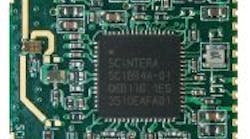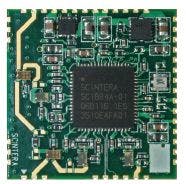Aiming For Higher Amplifier Efficiency
Lower amplifier (PA) efficiency can impact several operating parameters in a wireless communications system. In a portable device, low PA efficiency means short battery lifetime. In larger, higher-power systems, poor PA efficiency translates into more heat generated by the amplifier; if not effectively dissipated, it can shorten the amplifier’s lifetime. Efficiency has become one of the more important specifications for PA specifiers, almost on a par with gain and output power.
Efficiency in an amplifier essentially refers to how much DC power applied to the amplifier is converted into RF output power. It typically pertains to drain efficiency or the DC power applied to the drain of the field-effect transistors (FETs) in the amplifier. The term power-added efficiency (PAE) is another parameter used to compare amplifier efficiency, which also takes into account the gain of the amplifier. An amplifier with low level of gain, for example, will have considerably less PAE than drain efficiency, while an amplifier with high gain will have PAE close in value to its drain efficiency.
Power amplifiers are categorized into different classes based on their efficiency. In Class A biasing, the amplifier’s transistors remain powered or conducting at all times. In Class B, usually two or more transistors are used in the amplifier, with each conducting 50% of the time. It provides much more efficiency than a Class A amplifier, but sacrifices linearity.
A variation of the Class B configuration, the Doherty amplifier, was originally used with a pair of vacuum tubes to achieve high efficiency at high power levels. Class AB combines traits of both Class A and B approaches. In a Class C amplifier, the efficiency is increased by operating the active devices in conduction less than 50% of the time, although linearity is further reduced. In Class D and higher amplifiers, various switching approaches are used to further increase efficiency.
Linearity and efficiency have long been accepted tradeoffs in RF/microwave PA design, but now amplifier designers must attempt to optimize both parameters, especially when handing third-generation (3G) and fourth-generation (4G) signals with their advanced modulation formats. More-efficient amplifiers run cooler than amplifiers with low efficiency, helping to simplify the thermal management of a design and minimize reliability problems.
Linearity is of growing importance in newer communications systems that rely on variable-envelope modulation formats to carry large amounts of data on high-frequency signals. In a signal with constant-envelope modulation, the information is represented by either the phase or frequency of the signal. In a signal with variable-envelope modulation, the information is represented by the amplitude. Because the envelope changes, in theory, an amplifier’s supply voltage can be raised or lowered dynamically to adapt to the state of the envelope, conserving power consumed by the amplifier and boosting efficiency in the process.
This technique, known as envelope tracking, is one of a number of techniques developed over the years to increase amplifier efficiency without degrading linearity. Additional methods include various forms of adaptive feedback based on detecting or predicting the amplifier’s distortion characteristics and feedforward techniques, where the amplifier’s distortion is actually measured and a signal with the negative values of amplitude and phase are mixed with the amplifier’s signal to cancel the distortion.
Many of these methods can deliver quite effective results but, traditionally, have been expensive to implement because of their use of such components as high-speed data converters, broadband sensors, and precision delay lines. But as new techniques are developed and as the integration levels and speeds of semiconductor processes—such as silicon CMOS—continue to increase, many of these amplifier "add-on" efficiency boosters can be implemented in integrated-circuit (IC) form, often as a single device.
Most of the methods developed to improve amplifier efficiency and linearity involve the use of a dynamic supply voltage that changes with the signal envelope, as in envelope tracking, or generating some form of "correction signal" with the required amplitude and phase characteristics needed to cancel the amplitude and phase distortion nominally being added by the amplifier. The approaches differ by whether they add the correction signal to the input of the amplifier or mix it with the output signal.
Feeling Out Feedback
For example, predistortion feedback is based on tracking the intermodulation (IM) terms created by an amplifier and feeding a correction signal, with the opposite amplitude and phase characteristics of the nonlinearities, back to the input of the amplifier to cancel those variations. In practice, calculating or predicting the necessary gain and phase variations of the IM terms is difficult since they can vary with changes in temperature and bias supply. Often the correction factors are stored in memory in lookup tables to facilitate this feedback approach.
Additional feedback linearization approaches include Cartesian feedback, in which I and Q signals are fed to the amplifier to essentially tune the amplitude and phase distortion, and polar feedback, which uses two wideband control loops to make amplitude and phase corrections that are injected to the input of the amplifier. In feedforward techniques, in which a correction signal is generated from measurements of the amplifier’s output signal, delay lines are used to provide multiple signal paths, corrected and noncorrected (which is measured or detected). Implementing delay lines with consistent, repeatable characteristics over time, temperature, and process variations can be difficult. This has traditionally been one of the roadblocks to the widespread use of this amplifier linearization approach.
Any practical implementation of a PA efficiency/linearity scheme must provide adequate signal bandwidth to support the wide-bandwidth signals used in modern communications systems. Several companies have emerged with "add-on" solutions for PA designers, in the form of system-on-chip (SoC) or IC devices. Nujira (www.nujira.com), for example, has developed power modulator ICs based on its patented envelope tracking (ET) technology that apply for either high-power basestation or lower-power handset PAs (see Microwaves & RF, July 2012, p. 92). Its Coolteq® family of products includes the Coolteq.H power modulators for PAs to about 60 W and Coolteq.L ICs for use in mobile communications handsets. In a typical application, the ICs dynamically adjust the bias to the PA working in conjunction with input predistortion circuitry, to improve both efficiency and linearity. The firm’s Coolteq.L ICs, such as the model NCT-L1100, support channel bandwidths to 20 MHz for use with 4G Long Term Evolution (LTE) handsets. The chip, which includes an analog envelope interface and Mobile Industry Processor Interface (MIPI) RF front-end (RFFE) control interface, is compatible with multiple air interface standards.
Surveying The Field
To aid PA designers, the company recently launched the ET Surface Explorer software upgrade to its existing NCT-T9102 RF PA characterization system. It works with the test hardware to help PA designers visualize how their designs will behave with ET power supplies. The software is written to speed the amplifier characterization process by replacing thousands of repetitive measurements with a single measurement pass, taking only about two minutes to acquire the data on a PA circuit for modeling it under ET operating conditions. The combination of software and hardware improves measurement accuracy of PA efficiency under dynamic power-supply conditions.
Scintera (www.scintera.com) has developed a family of RF predistortion adaptive linearization (RFPAL) SoC solutions for improving the efficiency and linearity of cellular-base-station and small-cell PAs. The firm combines analog and digital circuitry in their radio-frequency power amplifier linearizers to produce predistortion linearization—all in compact device packages with low power consumption and wide channel bandwidths. Their predistortion solution is relatively simple to implement and does not require external host control, like many other PA efficiency/linearity-boosting solutions. Their solution targets Class A/AB amplifiers operating from 0.5 W output power and higher where predistortion solutions traditionally have not been used (due to cost), as well as Doherty amplifiers operating at 10 W output power and higher.
The company recently announced their model SC1894 third-generation RFPAL SoC for use with PAs in small cell sites and repeaters (see figure). It incorporates new features aimed at RF transmitters, including PA gate biasing, a temperature sensor, and dual RF power measurement capability—using on-board quad analog-to-digital converters (ADCs), quad digital-to-analog converters (DACs), and the ADCs associated with the RF input and RF feedback signals. The RFPAL SoC is suitable for operating frequencies from 168 to 4200 MHz and signal bandwidths from 25 kHz to 60 MHz. The SC1894 is housed in a standard 64-pin, 9 x 9 mm QFN package. The firm’s website features an efficiency calculator that allows visitors to enter power-consumption values for their own system to compare the efficiency of their PA with and without the RFPAL solution.
This RDB2-SC1894 circuit board (25 x 25 mm) surrounds a model SC1894 third-generation RFPAL SoC with all necessary components for improving the linearity and efficiency of a PA for small cellular base stations. [Photo courtesy of Scintera (www.scintera.com).]
Improved PA efficiency and linearity are also important to many military applications. Auriga Microwave (www.aurigamicrowave.com) recently completed a two-year Phase II Small Business Innovation Research (SBIR N08-039) program on improving the linearization of wide-band-gap amplifiers, including those based on gallium-nitide (GaN) device technology. The two-year effort resulted in high-efficiency 30-W PA prototypes aimed at the US Navy’s Next Generation Jammer (NGJ) system. The prototype amplifiers are suitable for a number of electronic-jamming applications requiring wide bandwidths and high linearity.

